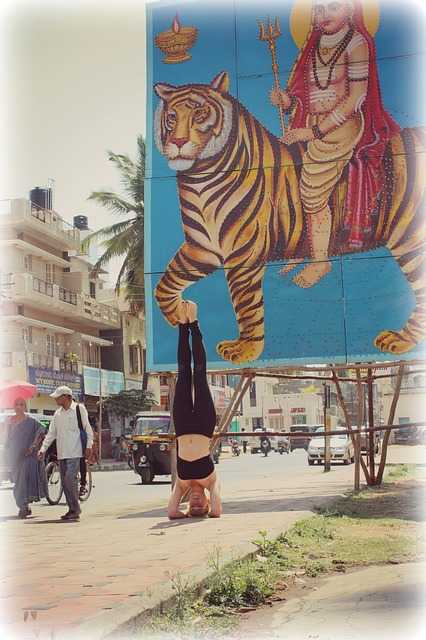

Shirshasana
«Shirshasana» also known as «Sirsasana» or «Headstand», is an Asana from Hatha Yoga, which is one of the 84 Main Asanas. «Shirshasana» is the 1st Asana of the Basic Postures of the Yoga-Vidya series. «Shirshasana» is the Sanskrit word for «Headstand». «Shirshasana» consists of two words, «Shirsha» and «Asana». «Shirsha» means head, also head point. «Asana» means stand, position. So is «Shirshasana» the «Headstand».
Table of Contents
1.1 Physical
1.2 Contraindications
1.3 Strengthened Muscles in Shirshasana
1.4 Mentally
1.5 Energetic
1.5.1 Chakras especially addressed in Shirshasana
2 Swami Sivananda about Shirshasana
3 Useful Tips for Shirshasana
4 Announcements of a Yoga Teacher for Shirshasana
5.1 The Video of Sukadev's Lecture about Shishasana, the Headstand
6 Videos on the subject Shirshasana
6.1 Headstand: Preliminary Exercises and Instructions
6.1.1 Shirshasana, Headstand Preliminary Exercises
6.1.2 Getting into the Headstand
6.1.3 Dog, Alternative for the Headstand
6.1.4 Crow and Clown, Alternatives for Shirshasana
6.1.5 Elbowstand, Alternative for Shirshasana
6.1.6 Headstand Alternative for a Cool Head
6.1.7 Shirshasana with Padmakshi
6.2.1 Scorpion and Headstand with Variations
6.2.2 Kopfstand, Shirshasana Variations
6.2.3 Headstand with Lotus
6.2.4 Clown, Variations of Shirshasana
6.2.5 Arm Variations in Shirshasana, the Headstand
6.3 Headstand and Scorpion for Advanced Practitioners
6.4 Help for Yoga Teachers
6.4.1 Helping into the Headstand
6.4.2 Headstand Assistance
Effects of Shirshasana
Physical
The carotid artery receives considerably more blood. The brain, spine and sympathetic nervous system are supplied with blood. Diseases of the nerves, eyes, ears, nose and throat disappear. This Asana is good for varicose veins, kidney colic and persistent constipation. This Asana is also good for lowering the stomach and nervous asthma. The lungs are cleaned because all bad air leaves the lungs. «Shirshasana» also improves the blood circulation of the scalp (reducing hair loss and slowing down the graying of the hair or hair loss) and the face (reducing wrinkles). The «Shirshasana» is considered to be «rejuvenating». Sense of balance, muscular coordination, self-confidence, concentration and courage are promoted.
Contraindications
Anyone suffering from severe high blood pressure, damage to the cervical spine or severe eye damage should consult a doctor before performing this Asana.
Strengthened Muscles in Shirshasana
Delta muscles (shoulder muscles).
Mentally
Many brain functions such as memory, concentration, creative thinking, mental clarity are increased. The «Shirshasana» develops courage, concentration, willpower, balance and coordination.
Energetic
The «Shirshasana» helps to sublimate the Apana and thus the sexual energy. It activates the sun and moon energies in the solar plexus and forehead.
Chakras especially addressed in Shirshasana
➳Ajna Chakra
➳Sahasrara Chakra
Swami Sivananda about Shirshasana
The «Shirshasana» is also known by other names such as «Kapalyasana» (Sanskrit: related to the skull or cranium) or «Vrikshasana» (like a tree), Viparitakarani (Sanskrit: the reverse action) and as Topsy-turvy (upside down). This Asana is the King Position among the Asanas.
Method
Spread a quadruple folded blanket. Sit on both knees. Make a finger closure by interlocking your fingers. Place them on the floor up to the elbows. Now keep your vertex on the finger fastener or between your hands. Slowly lift your legs up into the vertical. At the beginning stays like this for about 20 seconds. Gradually increase this time by 15 seconds each week until you remain in the Asana for 20 minutes or half an hour. Then slowly lower your legs again. Strong people can stay in the Asana for half an hour within a practice period of 2 or 3 months. Take your time. Don't try too hard. Be calm. The Eternity lies before you. Do not be careless in this matter. Practice this Asana on an empty stomach. If you have time, practice twice a day, morning and evening. Come into this Asana very slowly and avoid jerky movements. While standing on your head, breathe slowly in and out through the nose and never through the mouth.
You can put your hands on the floor at the side of your head. In case you have a slight tendency towards obesity, you will find this easier to practice. When you learn to balance in this Asana, you can move on to practice with your fingers folded. For those who can keep their balance in bar gymnastics or on the floor, this Asana is no trick. Ask a friend to help you keep your legs still while you practice, or use the wall as an aid when you start learning the «Headstand».
In the beginning, some may experience unexpected sensations during practice, but these will soon disappear. The Asana brings joy and happiness. After you leave the practice, rest for 5 minutes and drink a cup of milk (or rice milk). Those who stay in the Asana for a relatively long time, about 20 minutes or half an hour, should take a light refreshment, milk or something else, after coming out of the posture. This is very important. It is an absolute necessity. Don't hold the Asana that long in the summer. In winter you can practice for as long as you wish. There are people which stay in this Asana for two or three hours without a break. In Varanasi there was a Yogi who realized the state of «Samadhi» in this posture. Sri Jaspat Rai, P.V.Acharyaji Maharaj and others, regularly stayed in this Asana for one hour every day without interruption.
Benefits
In order to maintain Brahmacharya (purity of thought, word and deed or the observance of celibacy in order to experience Brahman), the Asana is very helpful and useful. It makes you an Urdhvaretas (Sanskrit: one who keeps the seed inside, who lives according to the principle of chastity). The sexual energy will be transformed into the spiritual Ojas-Shakti (highest spiritual life forces). This is also called sexual purification / sexual spiritualization. You will have no wet dreams, no spermatorrhea (uncontrolled discharge of semen without sexual arousal in advance).
In an Urdhvareto-Yogi the sexual energy flows upwards into the brain to be stored there as spiritual power, which is then used for contemplative purposes (Dhyana: meditation). When you practice this Asana, imagine that the sexual energy is transformed into Ojas (life force) and rises along your spine to be stored in your brain.
«Shirshasana» invigorates, energizes and stimulates.
«Shirshasana» is truly a blessing and nectar. Words cannot express the real benefits and effects of «Shirshasana». Alone in this Asana the brain can charge a lot of blood and «Prana». This works against gravity and sucks an excess of blood away from the heart. The memory improves admirably. Lawyers, occultists and thinkers will appreciate this Asana.
The Asana leads out of itself to natural «Pranayama» and «Samadhi». No other effort is necessary. If you observe your breath, you will notice that it becomes finer and finer. In the beginning of the practice there will be little difficulties in breathing. With progress in the practice, this will disappear completely. You will find real pleasure, joyful excitation of the mind in this Asana.
Great benefits can still be derived from this if a meditation follows the «Shirshasana». You will be able to hear Anahata sounds (Anahata is the 4th Chakra; Sanskrit: unwounded; the sound of heavenly realms) clearly. Young resistant persons should perform this Asana. The advantage out of this Asana is incalculable. Those who practice «Shirshasana» should not practice regular intercourse with a sexual partner. «Shirshasana» is also a panacea, a miracle cure, a superior specific for all diseases.
The Asana enlightens the psychic body and awakens the «Kundalini Power», eliminates all kinds of gastrointestinal diseases and strengthens the mental power. The "Shirshasana" has the effect of a powerful blood cleanser and that of a nerve tonic. All diseases of the eyes, nose, head, throat, stomach and abdomen, urogenital system, liver, spleen, lungs, renal colic, deafness, semen flow, diabetes, hemorrhoids, asthmatic diseases, syphilis, etc. can be cured in this way.
This Asana ignites the digestive fire Jatharagni (Sanskrit: Jathara — stomach; Agni — fire. Wrinkles and grey hair will disappear. «He who practices the Asana for three hours a day defeats the time» is written in the Yoga-Tattva-Upanishad. Even ladies can perform this Asana. Many diseases of the uterus and ovaries can be cured in this way. Sterility disappears.
Asanas (postures), «Pranayama» (breathing exercises) and Japa» (mantra recitation) should go hand in hand. While practicing these Asana repeat the Mantra of your Ishta Devata (Sanskrit: the highest personal god you have chosen) or the Mantra you have received from your teacher.
Always remember the precious words of Lord Krishnas: «Tasmat Yogi Bhava» — «Therefore become a Yogi" (Gita, Chapter, VI-46). Sri Prakash Jung, the private secretary of the last Maharajah of Tehri (the mountain state in Uttarakhand) in the Himalayas, had swollen legs and heart disease. The heart muscle could no longer properly contract and expand in its pumping function. This is how it was diagnosed by the doctors. For several days he practiced «Shirshasana» regularly. The whole swelling disappeared. The heart function was restored. He had no more pain at all. He practiced the Asana for half an hour daily. The pundit (scholar) Surya Narayan, a lawyer in Lakhimpure Kheri also did this Asana. His memory improved more and more. The chronic pain in his back and shoulders (chronic rheumatism) disappeared completely.
Useful Tips for Shirshasana
If you have great difficulty in getting into the «Headstand», this can have several causes:
➳Often beginners lack the appropriate abdominal muscles. You need these to be able to lift your legs from the ground in a controlled manner. Jumping in is less recommendable, on the one hand you could plop backwards. On the other hand, jumping in does not teach you to lift your legs in a controlled way and does not train your abdominal muscles. Do many abdominal exercises, also for the lateral abdominal muscles. It is better to practice regularly than a lot and only twice a week.
➳A beginner may lack strength and flexibility in the shoulders. Especially the shoulders do most of the work in the «Headstand», which could better be called «Forearmstand». Practice instead the «Dolphin» and the «Rabbit». Both will help you tremendously for the «Headstand».
It is not for nothing that the headstand is considered the King of Asanas. The effects as described by Swami Sivananda above are fantastic. Nevertheless, take care of your neck. Gradually improve yourself. Kings very rarely fall from the sky. Rather, they too must be trained and prepared for their task since childhood. Proceed skillfully. Good luck and success.
Announcements of a Yoga Teacher for Shirshasana
Starting position: You come from the «Position of the Child» and prepare you for the «Shirshasana»:
➳Measure the distance between your elbows correctly. Rather closer together than further apart.
➳Fold your hands together at the front so that one of your little fingers is on the inside. Place your hands open on the floor.
➳Place the flat part of the top of your skull on the floor in the basket of your hands and grasp the back of your head with your hands.
➳Straighten your legs and walk with your feet towards your elbows.
➳At some point the feet will lift up almost by themselves.
➳Angle your legs to straighten your hips up, take your legs up and only then straighten them completely.
➳When you arrived at the «Headstand», be careful that your forearms carry the weight. Keep your shoulders away from your ears. The head carries very little weight.
➳Relax everything that you do not need for this Asana. Become very calm and direct your concentration to the «Ajna Chakra» or «Sahasrara».
➳Hold you as long as it is easy possible for you. Always make sure that you carry your weight on your forearms and not on your head.
When coming out of the position, in the same way controlled as when coming in.
➳Afterwards, change in any case to the «Position of the Child».
Variations
I. Vrikshasana
II. Viparitakarani Mudra
III. Kapalyasana: The «Shirshasana» as described above is also often called with these 3 names.
IV. Ardha Vrikshasana: When you are in «Shirshasana» bend the legs in the knee joints and leave them in extension of the thighs.
V. Mukta Hasta Vrikshasana: Leave the hands next to the head on the floor instead of the finger lock.
VI. Hasta Vrikshasana: In this Asana you will have to stand alone on your two hands. Swing your legs against the wall first, standing on your hands only. Very slowly try to move your legs away from the wall. In a few days you will learn to keep your balance.
VII. Ekapada Vrikshasana: (sanskrit: ekapada — one leg). When you are in «Shirshasana», slowly bend one leg at the knee and keep the heel above the other thigh.
Sukadev about Shirshasana
The Video of Sukadev's Lecture about Shishasana, the Headstand

 |
 |
Videos on the subject Shirshasana
Headstand: Preliminary Exercises and Instructions
Shirshasana, Headstand Preliminary Exercises
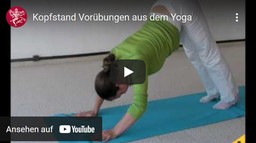
 |
 |
Getting into the Headstand
First there are two videos that show a relatively simple method to get into the «Headstand». This «Headstand» is better known as the «Handstand», more specifically as the «Tripod Handstand».
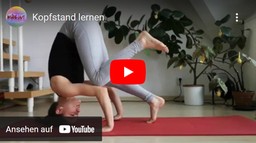
 |
 |

 |
 |
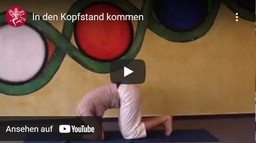
 |
 |
Dog, Alternative for the Headstand
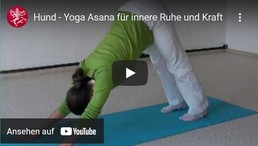
 |
 |
Crow and Clown, Alternatives for Shirshasana
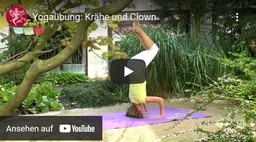
Elbowstand, Alternative for Shirshasana
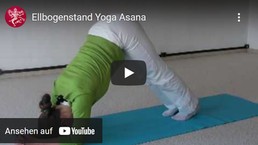
 |
 |
Headstand Alternative for a Cool Head

Shirshasana with Padmakshi
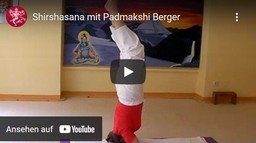
 |
 |
Shirhasana Variations
Scorpion and Headstand with Variations

 |
 |
Headstand, Shirshasana Variations
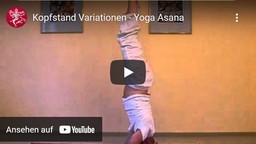
 |
 |
Headstand with Lotus
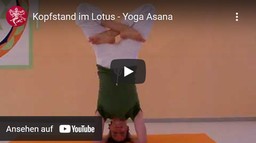
 |
 |
Clown, Variations of Shirshasana
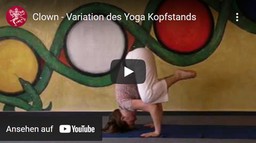
 |
 |
Arm Variations in Shirshasana, the Headstand
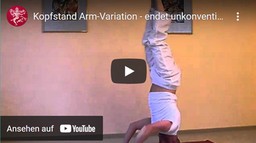
 |
 |
Headstand and Scorpion for Advanced Practitioners
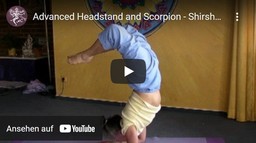
 |
 |
Help for Yoga Teachers
Helping into the Headstand
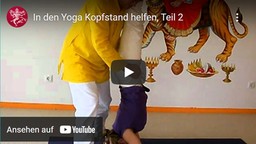
 |
 |
Headstand Assistance
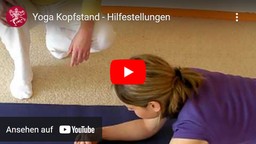
 |
 |

 Shirshasana
Shirshasana